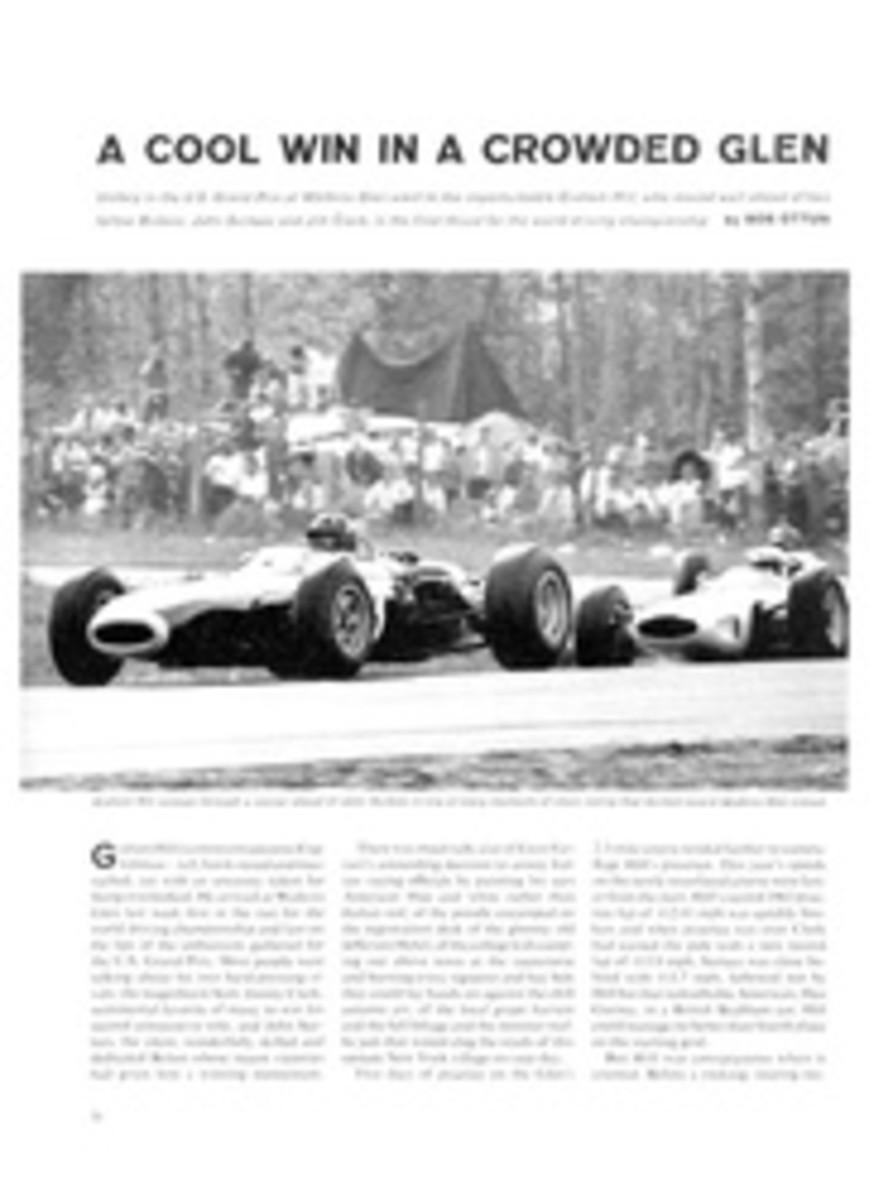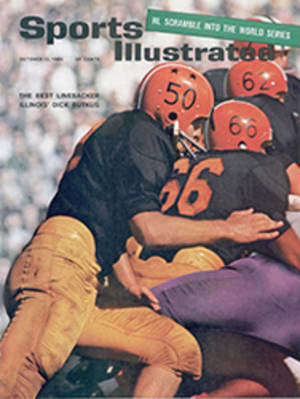
WHERE THE ANTELOPE PLAY
From a vantage point high above the vast, windswept plains of eastern Montana the search begins with the sun's first slanting rays as two hunters look for pronghorn antelope through binoculars and rifle scope. Once a herd is spotted, the hunters will try a decoying stalk (below), using their pickup truck to distract the game while one of the riflemen crawls into position for a long, standing shot. Although antelope appeared to be heading for extinction by the turn of the century, their survival has now been virtually guaranteed by the efforts of aroused conservationists and the wise management of game technicians. The antelope population of the U.S. is now close to 400,000, and this fall's kill—some 80,000 hunters will come home from the prairie with an antelope—represents a well-controlled and desirable harvest. On these and the following pages Artist Bill Shields portrays some of the more unforgettable moments of a Montana hunt. For more on this unique and striking animal—where he is hunted and how—see page 52.
ACHES, PAINS AND PRIZES
From the Continental Divide to the Dakotas, the antelope country of eastern Montana—thousands of square miles of rolling plains covered with short grass and sagebrush, out of which spring sharp ridges, high rimrock benches and tumbled badlands—has been variously described as lonely, monotonous and forbidding. For most of the year these descriptions are precise enough. The bitter winters often bring temperatures of 40° below zero, and summer droughts bake the prairie until it wrinkles and cracks like a dried prune. The annual rainfall seldom reaches 10 inches, yet a heavy shower can fill the dry creeks and arroyos and turn the prairie to mud. But in October—the antelope season—the weather is at its most bearable, and a hunter exulting over his first pronghorn antelope might even look fondly on this remote and rugged part of the West.
It doesn't take a hunter very long to figure out that the prairie is not as flat as it appears. Stretched out and low to the ground, antelope can gallop along at close to 60 mph, and a herd of 40, their white rump hairs erect and shining like heliographs in the sun, can vanish over a rise that is barely visible through binoculars. Usually they will pop up again a mile or so away and browse restlessly, keeping the hunter in sight but out of rifle range. Shooting such a perceptive animal is not simply a matter of patience or skill. The hunter makes exhausting stalks on nervous herds by running crouched over through cottonwood-choked gullies and dry washes that score the prairie. His lips crack from the wind, and the dust he inhales clogs his sinuses and leaves his mouth as dry as the land. His belly and bottom are jabbed raw by prickly-pear cactus spines and sharp rocks. His joints ache from jolting over the prairie in a pickup truck. He comes on prairie rattlers lying torpid in the hot, midday sun and lives to tell the tale—over and over.
But the antelope hunter happily welcomes such misery, for his chances of bagging an antelope are very good indeed. Next to the deer, the antelope is the country's most heavily harvested big-game animal, and this fall more than four of every five hunters lucky enough to draw permits in 14 states will bring home antelope. The biggest kill—more than 70%—will be in Montana and Wyoming, two of seven states that permit nonresident riflemen to participate in the drawings. Hunters are more than welcome on most ranches, and the landowner will often help them locate antelope. The hunter with limited time would do well to hire one of the outfitters to be found in nearly every prairie town.
The fact that there are close to 400,000 antelope in western North America today is a tribute to one of the most successful game-management campaigns in history. Between 1850 and 1900 there was open season on anything that moved on the plains, and by the time Dr. Brewster Higley wrote the cowboy classic Home on the Range in 1873 the word about antelope was indeed discouraging. At the turn of the century less than 20,000 antelope remained of the estimated 50 million that once roamed freely over the plains from Illinois to the Pacific Ocean and from the Canadian prairies south into Mexico. Those that did survive the Indians, market hunters and early settlers were already imprisoned on a prairie habitat that was being methodically fenced, plowed and overgrazed by cattle and sheep.
Finally Westerners awoke to the fact that the antelope was going the way of the bison—and a conservation conscience manifested itself on the plains. Game departments throughout the West closed all seasons. Antelope refuges were established through the efforts of the Boone and Crockett Club and the National Association of Audubon Societies. The Federal Government sponsored predator-control campaigns, and wildlife experts elicited the aid of stockmen by showing them that the antelope's diet consisted to a great extent of sagebrush and forbs, and it was therefore not a serious competitor to livestock on grazing land. Between 1946 and 1952 Montana game men moved 4,200 antelope to areas where native populations were small or nonexistent. The Montana herd has increased from 12,000 in 1940 to more than 100,000 today. So successful have such trapping and restocking programs been that several states now have all the antelope that can be properly supported by available habitat and range.
The pronghorn antelope (Antilocapra americana, or American goat-antelope) is native to North America and not even remotely related to the antelopes of Africa or Asia. Though considered a big-game animal, antelope are surprisingly small and slight. A mature buck stands about three feet tall at the shoulders and weighs, on the average, 115 pounds. His fragile outer horn shells are shed every year and new ones grow in. The doe frequently has horns, but they rarely extend beyond her long, pointed ears. All but two antelope states permit hunters to shoot bucks and does, and the average harvest is two bucks for every doe.
Despite the high hunter success, the sharp-eyed pronghorn is indeed a challenging animal. Long shots—at least 200 yards and often twice that far—are common and, from 400 yards across a wind-blown prairie, even a standing antelope is a difficult target. Most hunters take running shots with all the confidence of a 13-year-old doing the frug in her first strapless dress.
Were it not for the wire fences that enclose the antelope in large pastures on much of its range, the annual hunter harvest would be cut considerably. Antelope can leap 20-foot ditches, and they will jump eight feet straight up in the air inside a trapping pen. But only rarely will they jump over a fence, preferring instead to slide under or squeeze through it when they can. Predictably, not a few hunters take unfair and illegal advantage of this foible by herding antelope into fence corners with trucks, jeeps, trail scooters and even golf carts, and then mowing them down.
Encroaching civilization and poor game management may soon eliminate antelope from much of their present range. But the large, carefully controlled herds in Montana, Wyoming, Colorado, Nebraska and the Dakotas should provide sport for many years. Says Washington State University Zoologist Helmut K. Buechner: "The pronghorn can be perpetuated as an economic asset in excellent harmony with other land-use objectives"—which means that the hunter can continue to broil antelope steaks over a crackling prairie campfire and then head for home with his prize and the happy memories of the misery he endured to bag it.
TWO ILLUSTRATIONS
BILL SHIELDS
ILLUSTRATION
BILL SHIELDS
Curious but alert antelope, their powder-puff rumps bright against a dull, parched prairie, watch two incautious hunters top a rise between buttes. In a moment the hunted will trot safely out of rifle range.
TWO ILLUSTRATIONS
BILL SHIELDS
In the brilliant glow of a western sunset a buck antelope is carried up a grassy draw to a pickup truck. Before leaving the prairie for the ride back to town, the lucky hunter, after patient hours of squinting through binoculars across the rolling land and a successful, heart-pounding stalk, poses proudly in the traditional manner with his trophy pronghorn.
ILLUSTRATION
BILL SHIELDS
A neon oasis on the great broad plains, the little cow town of Ekalaka, Mont. (right) welcomes visiting antelope hunters. Tired from a long day in the open, their jeans, cartridge belts and boots caked with dust, they roll into town to stock up on supplies, eat fried steak and discuss the day's success or lack of it over drinks and cards at the local cafés.

